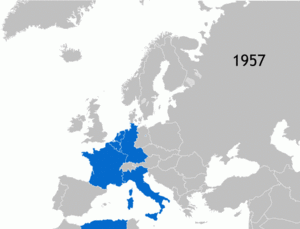TREVI
Part of a series on the |
||||||||||||||||||||||||
|---|---|---|---|---|---|---|---|---|---|---|---|---|---|---|---|---|---|---|---|---|---|---|---|---|
| History of the European Union |
||||||||||||||||||||||||
 | ||||||||||||||||||||||||
|
||||||||||||||||||||||||
|
Organisation
|
||||||||||||||||||||||||
|
||||||||||||||||||||||||
|
||||||||||||||||||||||||
|
Topics |
||||||||||||||||||||||||
| European Union portal | ||||||||||||||||||||||||
TREVI was an intergovernmental network - or forum - of national officials from ministries of justice and the interior outside the European Community framework created during the European Council Summit in Rome, 1–2 December 1975. It ceased to exist when it was integrated into the so-called Justice and Home Affairs (JHA) pillar of the European Union (EU) upon the entry into force of the Treaty of Maastricht in 1992.
The first TREVI meeting at the level of senior officials was held in Rome where the famous Trevi Fountain is located and the meeting was chaired by a Dutchman by the name of Fonteijn (which translates into English as fountain). In some French textbooks it is sometimes noted that TREVI stands for Terrorisme, Radicalisme, Extrémisme et Violence Internationale.
The creation of TREVI was prompted by several terrorist acts, most notably the hostage taking and subsequent massacre during the 1972 Olympic Games in Munich, and the inability of Interpol at that time to effectively assist the European countries in combatting terrorism. While TREVI was initially intended to coordinate effective counter-terrorism responses among European governments, it slowly extended its remit to many other issues in cross-border policing between the members of the European Community. Many of the practices and a large part of the structure of the former Third Pillar traced their origins to TREVI.
| Signed In force Document |
1948 1948 Brussels Treaty |
1951 1952 Paris Treaty |
1954 1955 Modified Brussels Treaty |
1957 1958 Rome treaties |
1965 1967 Merger Treaty |
1975 N/A European Council conclusion |
1985 1985 Schengen Treaty |
1986 1987 Single European Act |
1992 1993 Maastricht Treaty |
1997 1999 Amsterdam Treaty |
2001 2003 Nice Treaty |
2007 2009 Lisbon Treaty |
|||||||||
| Three pillars of the European Union: | |||||||||||||||||||||
| European Communities: | |||||||||||||||||||||
| European Atomic Energy Community (EURATOM) | |||||||||||||||||||||
| European Coal and Steel Community (ECSC) | Treaty expired in 2002 | European Union (EU) | |||||||||||||||||||
| European Economic Community (EEC) | |||||||||||||||||||||
| Schengen Rules | European Community (EC) | ||||||||||||||||||||
| TREVI | Justice and Home Affairs (JHA) | ||||||||||||||||||||
| Police and Judicial Co-operation in Criminal Matters (PJCC) | |||||||||||||||||||||
| European Political Cooperation (EPC) | Common Foreign and Security Policy (CFSP) | ||||||||||||||||||||
| Unconsolidated bodies | Western European Union (WEU) | ||||||||||||||||||||
| Treaty terminated in 2011 | |||||||||||||||||||||
See also
Further reading
- Anderson, M., M. den Boer, P. Cullen, W. Gilmore, C. Raab and N. Walker. (1995) Policing the European Union. Theory Law and Practice. Oxford: Clarendon Press.
- Hebenton, B. and T. Thomas (1995) Policing Europe. Co-operation, Conflicts and Control. New York: St. Martin’s Press Inc.
- Nilsson, H. (2004) ‘The Justice and Home Affairs Council’, in M. Westlake and D. Galloway (eds) The Council of the European Union. London: John Harper Publishing.